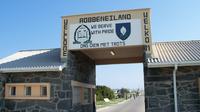Full-Day Walk to Freedom Tour in Cape Town Including Robben Island
Cape Town, South Africa
Rating: 









Trip Type: Full-day Tours
Duration: 9 hours
This tour offers a wealth of insight into South Africa’s history and past injustices, the legacy of the struggle and the promise of reconstruction and development initiatives under way at present.
More About This Activity All Full-day Tours →
This tour offers a wealth of insight into South Africa’s history and past injustices, the legacy of the struggle and the promise of reconstruction and development initiatives under way at present.
“No easy road to freedom” was a central theme in most of the Mass Democratic Movement’s campaigns, from the early days through to the late 1980s. Any understanding of present day conditions in South Africa is greatly enhanced by looking at past injustice, the legacy of the struggle and the promise of reconstruction and development initiatives under way at present. Freedom has not come easy. This tour offers a wealth of insight into South African history. It includes a brief educational introduction to Cape Town, one of the world’s most varied and popular cities.
The Bo-Kaap: A look at the picturesque “Malay Quarter”, a living cultural museum and home to the oldest mosque in the Southern Hemisphere. We discover the unique culture, lifestyle and personality of the Cape Muslim community and their contribution to South Africa’s development.
District Six: As a result of the Group Areas Act, 60 000 Capetonian families were forcibly removed from this once vibrant area between 1966 and 1982. The District Six issue remains crucial. We examine the now desolate area, Zonnebloem, which was District Six and visit the living museum which attempts to represent and recapture District Six in various ways – as a fine-spun tapestry of communal life torn apart but not forgotten.
The Townships and Cape Flats: Seeking racial segregation, apartheid policies disrupted all non-white population groups, distorted both rural and urban development and ensured hopeless overcrowding. Few houses were built. Sprawling satellite camps of seemingly endless shanties – makeshift structures of various materials – provide little more than a roof and some shelter. As we shall see, squatter settlements are seeking their own solutions as an economic necessity. Against all odds, township life prevails, in all its nuances.
Robben Island: Formerly a political prison and leper colony before that, this historic landmark was recently established as a museum and national monument. Experience the conditions of incarceration – view Nelson Mandela’s maximum-security prison cell (Cell 5) and see the lime quarries. In the one, hard labour was served, in the other prisoners discussed strategy, freedom and the future. Later, many would develop eye problems as a result of the sun’s reflection off the lime surfaces. This well-preserved landmark is a monument to the triumph of freedom, dignity and determination over humiliation and oppression.
On Robben Island, visitors’ movements are restricted by regulation to the bus and the group’s guide. Tours of the island are conducted in large buses. On return to the V & A Waterfront you will be escorted back to your hotel.
“No easy road to freedom” was a central theme in most of the Mass Democratic Movement’s campaigns, from the early days through to the late 1980s. Any understanding of present day conditions in South Africa is greatly enhanced by looking at past injustice, the legacy of the struggle and the promise of reconstruction and development initiatives under way at present. Freedom has not come easy. This tour offers a wealth of insight into South African history. It includes a brief educational introduction to Cape Town, one of the world’s most varied and popular cities.
The Bo-Kaap: A look at the picturesque “Malay Quarter”, a living cultural museum and home to the oldest mosque in the Southern Hemisphere. We discover the unique culture, lifestyle and personality of the Cape Muslim community and their contribution to South Africa’s development.
District Six: As a result of the Group Areas Act, 60 000 Capetonian families were forcibly removed from this once vibrant area between 1966 and 1982. The District Six issue remains crucial. We examine the now desolate area, Zonnebloem, which was District Six and visit the living museum which attempts to represent and recapture District Six in various ways – as a fine-spun tapestry of communal life torn apart but not forgotten.
The Townships and Cape Flats: Seeking racial segregation, apartheid policies disrupted all non-white population groups, distorted both rural and urban development and ensured hopeless overcrowding. Few houses were built. Sprawling satellite camps of seemingly endless shanties – makeshift structures of various materials – provide little more than a roof and some shelter. As we shall see, squatter settlements are seeking their own solutions as an economic necessity. Against all odds, township life prevails, in all its nuances.
Robben Island: Formerly a political prison and leper colony before that, this historic landmark was recently established as a museum and national monument. Experience the conditions of incarceration – view Nelson Mandela’s maximum-security prison cell (Cell 5) and see the lime quarries. In the one, hard labour was served, in the other prisoners discussed strategy, freedom and the future. Later, many would develop eye problems as a result of the sun’s reflection off the lime surfaces. This well-preserved landmark is a monument to the triumph of freedom, dignity and determination over humiliation and oppression.
On Robben Island, visitors’ movements are restricted by regulation to the bus and the group’s guide. Tours of the island are conducted in large buses. On return to the V & A Waterfront you will be escorted back to your hotel.
« Go Back

